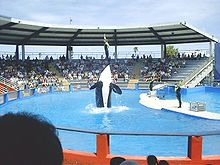Miami Seaquarium
In addition to marine mammals, the Miami Seaquarium houses fish, sharks, sea turtles, birds, and reptiles.
The park offers daily presentations and hosts overnight camps, events for boy scouts, and group programs.
[10] In January 2024, the USDA was satisfied that the operators had addressed issues related to their notice of intent to confiscate to remove certain animals.
[13] In March 2024, Miami-Dade County sent a lease termination notice to The Dolphin Company, giving the Seaquarium's owner until April 21 to move out.
[15] One of the Miami Seaquarium's attractions was Lolita, who, at the time of her death in 2023, was the second oldest orca in captivity after Corky at SeaWorld San Diego.
[17] On January 24, 2014 the National Marine Fisheries Service proposed amending the Endangered Species Act to remove the exception that did not include Lolita as part of the ESA-listed Southern resident orcas that live in Washington and British Columbia waters.
Activists, who proposed such an action to the NMFS in 2013, were hopeful that this might lead to a healthy retirement in a seapen and possibly an eventual release and reuniting with her pod which is believed by some to include her mother.
The Lummi Nation of Washington State referred to Lolita as Sk’aliCh’elh-tenaut, or a female orca from an ancestral site in the Penn Cove area of the Salish Sea bioregion.
"[21] In response, environmental scholars and Julius have argued that such statements are representative of a troubling pattern of discounting Native American knowledge and relationships which are "part and parcel of the possessive nature of settler colonialism.
"[18] The Miami Seaquarium announced on March 30, 2023, that Lolita was expected to be returned to her natal waters in the Pacific Northwest and reside in a semi-wild sea-pen in the Salish Sea for the remainder of her life.



